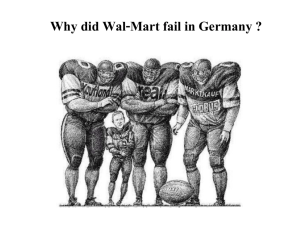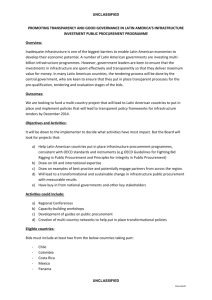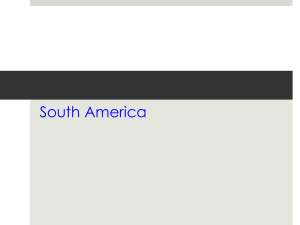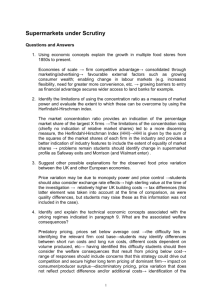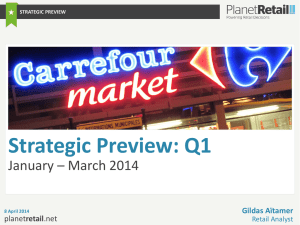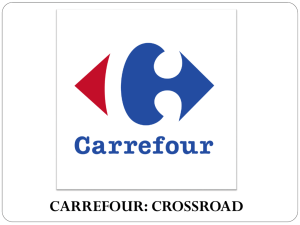The Rapid Rise of Supermarkets in Latin America
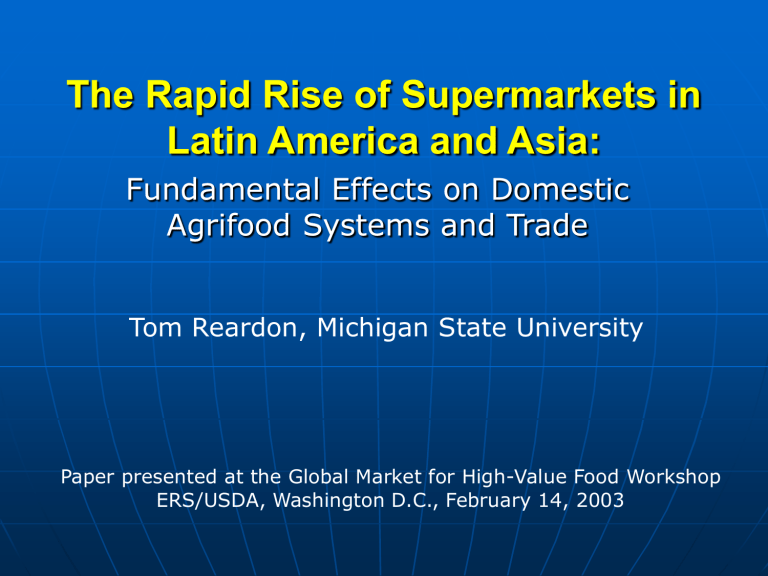
The Rapid Rise of Supermarkets in
Latin America and Asia:
Fundamental Effects on Domestic
Agrifood Systems and Trade
Tom Reardon, Michigan State University
Paper presented at the Global Market for High-Value Food Workshop
ERS/USDA, Washington D.C., February 14, 2003
Presentation outline
Focus on Latin America and Asia.
Supermarket diffusion pattern and determinants.
Effects on agrifood markets
-- procurement
-- standards
-- convergence
Challenges and Opportunities
Patterns and Determinants of
Supermarket Diffusion in Latin America and Asia
In 1 Decade Latin American Super
Market Diffusion Achieves the U.S.
Level Achieved in 5 Decades
Supermarket Share in national food retail
U.S.
Brazil
5-10% (1930) 80% (2000)
30 (1990)
Argentina 17 (1985)
Mexico
75 (10%/year)
57 (9%/year)
45
Chile 50
Costa Rica 50
Honduras
Guatemala: 30 (1999)
42
35 (2001)
Supermarkets In E/SE Asia: 5 years behind
Latin America but grow faster
Tom, what are the figures? # of stores, % growth? If % growth, the 3 rd column should be b-a, if # it should be (b-a)/a.
(a) 1999 (b) 2001 b/a
Indonesia 20
Thailand 35
China (urb) 30
Malaysia 27
Philippines 52
Rep.Korea 61
25
43
48
31
57
65
1.22
1.22
1.60!!
1.16
1.10
1.07
Focus on China
3000 supermarkets in China today
Investment starting and planned post-
WTO: 5-10 TIMES MORE in 5-7 years!
NOWHERE HAVE SUPERMARKETS EVER
GROWN THIS FAST
Mainly in urban, East and Southeast
But moving fast into North& South-west
60% share of food retail in Shanghai!
Procurement VOLUMES are Impressive
3 of 10 pesos spent by Mexicans on food are spent in… Wal-mart Mexico
Chinese supermarkets buy $2 billion F&V!
Supermarkets in Mexico and Central
America buy $3.3 billion in F&V
Supermarkets IN Latin America buy 2.5 times more F&V to sell to local consumers than Latin America exports to the world!
•
•
•
•
Determinants of supermarket growth in the two regions
DEMAND: Income growth & urbanization
POLICY: Liberalization of FDI in retail
- Mexico, Argentina, Brazil: 1994
- China 1992 -- Indonesia, 1998
- India, 2000…
SUPPLY: TIDAL WAVE of FDI: Europe and U.S.
- pushed by saturated markets
- pulled by growing markets & profit new retail management and logistics systems and technologies
•
•
•
•
•
Spatial & socioeconomic path of expansion
“Domino effect” – first and fastest in the largest or richest countries (
Brazil, Taiwan, Korea)
Then spreads over a region
-
Hong Kong, Taiwan, Japan, Korean chains China
-
Costa Rican chain into Nicaragua
Large cities
in intermediate cities
small cities/towns
Rich neighborhoods
middle class poor
Changing formats , hypermarkets, Hard discounts, convenience store chains
Regional multinational chains emerge
- December 1999: Ahold and Paiz form a JV in Guatemala
- January 2002: CARHCO: Paiz-Ahold and
CSU (Costa Rica) form JV
253 stores in 5 countries annual sales of 1.3 billion dollars!
buy $100 million of F&V…
Leads to rapid Consolidation
LAC: Top 5 chains average 65% of the sector vs 40% in US
70-80% global multinational owned by Walmart, Carrefour, Ahold
Losers in the retail sector
•
Reduction in “central markets”, wet markets
Rapid disappearance of “mom and pop stores”
- Argentina: 1984-93, 64,000 small stores close
Effects on agrifood markets
Local, national, regional, global
Procurement System Changes
Hypothesis: Procurement Officer will decide world trade patterns over the next decade
He/she thinking: “Beat Wal-mart, Beat Wet-market”
VOLUME procured and sold
COST (of product and transaction)
QUALITY and SAFETY
CONSISTENCY
Differentiate Products
Effect on Agrifood Market Organization
CONSOLIDATION PROCUREMENT SYSTEMS
By store, distribution center (DC) by zone, by country, by region
Global sourcing networks
DEFRAGMENTING of systems geographically larger volume per supplier, fewer suppliers
SHIFT FROM TRADITIONAL TO SPECIALIZED wholesalers, brokers, export firms with new domestic functions
Example: Hortifruti in Central America
Examples of procurement consolidation
> Carrefour in Brazil – JV with Penske
Logistics
> Carrefour: same in China 2003
> Lianhua in China – JV with Tibbett and
Britten Logistics, 2002/3
East Coast US: AHOLD, April 2002
… Michigan farmers’ reactions…
Winners
3 melon producers in North-east Brazil, Dec 2001
… TRACTOR-BEAMED into the Carrefour Global
Sourcing System
… 67 Carrefour HYPERMARKETS in Brazil
… and to 21 Countries!
… move from local market to global trade success…
Losers
The SHOCKED tomato producers of Nicaragua
– suddenly competing with Costa Rican tomateros IN THEIR OWN BACKYARD
… via procurement system of HORTIFRUTI
Traditional Wholesale
Market in Nicaragua
Michigan, Chilean, Washington, Oregon apples: HORTIFRUTI, Nicaragua
Effects on Market Institutions
Hypothesis: CONVERGENCE of institutions over regions
Gradual Rise of use of contracts
RAPID rise of PRIVATE STANDARDS
… HYPOTHESIS: more important than public standards in non-commodity trade
- agribusiness/retail strategic tools in global markets
- differentiate products
- coordinate supply chains
- missing or inadequate public standards
Use of standards by firms
Carrefour applies same Carrefour Quality
Certificate to 200 items around the globe
Hortifruti has CARHCO-specific private standards
Collective private standards EUREPGAP for produce
Pick ‘n Pay in South Africa applies EUREPGAP to local suppliers prefers exporters
CIES food safety initiative
200 largest supermarket chains, 200 largest suppliers
CIES: 2.8 TRILLION DOLLARS
Do they have the clout to affect markets?
… same players as now are dominating retail in Latin America and Asia
Challenges and Opportunities for
Local and Global Suppliers
The distinction between the export market and local market is disappearing
… GLOBAL MARKET BECOMES THE LOCAL MARKET!
Markets are defragmenting and integrating
Intraregional and interregional changes: trade implications
Regional markets are easier (transaction costs), and harder (standards) target for suppliers
Small producers have big problems
Big problems adapting to the institutional and organizational changes –
… and their technology and management requirements
Example: Cooperativa ASUMPAL, tomatoes contract for McDonalds, Guatemala
- demands stringent private standards
- implied investments: drip irrigation, greenhouses, hygienic services… $$$$
Stringent standards discourage some small farmers
ASUMPAL: 330 members in 2000… 30 in 2001
TOPS Thailand: “250 to 50 to 10” vegetable suppliers
Brazil dairy: 61,000 small dairy farmers
“DELISTED”, 1996-2000
While some others succeed
INDAP, small farmer vegetable cooperative,
Purranque, Chile
Melon growers in Brazil
California onions and Michigan apples to
Nicaraguan supermarkets
